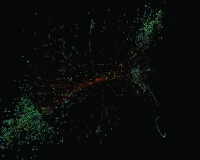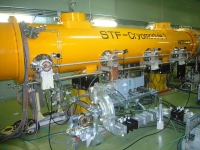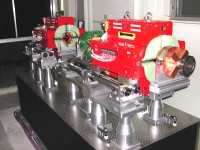 |
|
|
 |
Higgs makes for exotic couples
Today's issue features a guest essay by James Wells, a theorist working at CERN who specialises in physics beyond the Standard Model.

Simulation of the production and decay of a Higgs boson together with a Z boson at an electron-positron linear collider. Image: Norman Graf |
Much of the history of particle physics has been devoted almost exclusively to finding out what our bodies are made of. We first learned about protons and electrons and neutrons because they constitute the matter that makes up our bodies, and we learned of photons (light) because it interacts with our bodies when we see. Up and down quarks are the constituents of protons and neutrons, and they are held together by gluons, carriers of the strong force. Neutrons turn into protons through the weak force. Thus, everything we study has a close connection to our physical bodies. Even exotic particles, such as charm quarks or tau leptons are merely nearly exact copies of particles that make up our bodies: only their masses are different.
Read more...
-- James Wells |
 |
|
|
 |
Upcoming meetings, conferences, workshops
18th International Symposium on Spin Physics (SPIN 2008)
University of Virginia, Charlottesville, VA, USA
6-11 October 2008 CLIC08 Workshop
CERN
14-17 October 2008
Joint Workshop on Detector Development for Future Particle Physics and Photon Science Experiment
DESY Hamburg, Germany
16-17 October 2008
2008 IEEE Nuclear Science Symposium and Medical Imaging Conference
Dresden, Germany
19-25 October 2008
TTC Meeting
New Delhi, India
20-23 October 2008
Positron Source Meeting
Daresbury Laboratory, UK
29-31 October 2008
SiD Meeting at LCWS08
Venue in Chicago to be announced
15 November 2008  International Linear Collider Workshop (LCWS08 and ILC08) International Linear Collider Workshop (LCWS08 and ILC08)
University of Illinois at Chicago, Chicago, USA
16-20 November 2008
Upcoming school
Third International Accelerator School for Linear Colliders (2008 LC School)
Oak Brook, Illinois, USA
19-29 October 2008
|
|
 = Collaboration-wide Meetings = Collaboration-wide Meetings
GDE Meetings calendar
View complete ILC calendar
|
|
|
 |
2008 Nobel Prize goes to particle physics

Yoichiro Nambu (left, Photo: SCANPIX), Makoto Kobayashi (centre, Photo: University of Chicago) and Toshihide Maskawa (right, Photo: Kyoto University) |
This year's Nobel Prize in physics was awarded to a Japanese-born American and two Japanese particle physicists: Yoichiro Nambu, professor emeritus at University of Chicago, for the discovery of the mechanism of spontaneous broken symmetry in subatomic physics, Makoto Kobayashi, professor emeritus at KEK and executive director of the Japan Society for the Promotion of Science, and Toshihide Maskawa, professor at Kyoto Sangyo University in Kyoto, for the discovery of the origin of the broken symmetry which predicts the existence of at least three families of quarks in nature.
Read more...
-- Rika Takahashi |
 |
|
|
 |
From Prime Minister of Japan and his cabinet homepage
8 October 2008
ノーベル物理学賞日本人3人の受賞について
...リニアコライダー国際研究所建設計画というのがございます。...これから日本政府としても本格的に取り組む時が来た、これ今検討に入っておりますが、こうした横断的な分野の基礎科学について、具体的な政府の取り組みをやる、関係府省で検討する仕組みを作っていく必要があるんじゃないかと思っておりまして.
Read more... |
|
From NIKKEI NET
8 October 2008
官房長官、基礎科学を戦略的政策に ノーベル賞受賞で
...超電導技術で加速した電子や陽電子を全長40キロメートルのトンネルで衝突させる「リニアコライダー国際研究所」の建設計画にも言及し、「日本政府としても本格的に(誘致に)取り組む時が来た」と指摘した。
Read more... |
|
From SANKEI NEWS
8 October 2008
【ノーベル物理学賞】政府、リニアコライダー誘致に前向き
...今回のノーベル物理学賞受賞を追い風に、世界史上最大の高エネルギー電子加速器を建設する「リニアコライダー計画」の日本誘致を前向きに検討する考えを示した。
Read more... |
|
From YOMIURI ONLINE
8 October 2008
官房長官、巨大粒子加速器誘致に前向き…ノーベル物理学賞受け
河村官房長官は8日午前の記者会見で、日米欧などが進める巨大粒子加速器「国際リニアコライダー」(ILC)計画について、「政府として本格的に取り組むときが来た。関係府省で検討する仕組みをつくる必要がある」と述べ、日本国内への誘致に前向きな姿勢を示した。
Read more... |
|
From AFP
8 October 2008
Japan ready to host new 'Big-Bang' project
..."We want to make arrangements so that Japan can take on leadership," said Chief Cabinet Secretary Takeo Kawamura, the government's spokesman.
Read more... |
|
From The California Aggie
8 October 2008
The California Aggie
...If supersymmetry exists, while some supersymmetric particles can be discovered with the LHC, to really understand them requires a new machine, a linear collider that will collide electrons and positrons. The development of such a machine, which is decades away, has begun as a truly international effort called the International Linear Collider, Breedon said in an e-mail interview.
Read more... |
|
From symmetry breaking
7 October 2008
Physics Nobel for matter-antimatter difference and symmetry breaking
...It was really the predictions by Kobayashi and Maskawa that opened the possibility of seeing CP violation in B mesons and that led to the creation of the BaBar and Belle experiments.
Read more... |
|
From Discovery Channel
7 October 2008
The World's Next Big Atom Smasher
Dave Mosher chats with Barry Barish, head of the design effort for the biggest machine ever conceived
Read more... |
|
From CERN Bulletin
6 October 2008
Successful test for CLIC
The CLIC collaboration has commissioned its new installation and put the first beam into operation.
Read more... |
|
From Fermilab Today
6 October 2008
Labs and companies collaborate on pixel detector technology
Fermilab hopes to greatly improve the performance of its next generation of particle detectors by partnering with business to boost innovation.
Read more... |
|
|
 |
Preparations for S1-global at the STF at KEK

High-power tests of the first installed cavity in July 2008 |
Research and development on superconducting radiofrequency (rf) cavities, cryomodules and operational units is at the core of our programme to develop the technologies, the best possible machine design and an implementation plan for the ILC. As a central part of that programme, KEK is carrying out an ambitious plan to build and operate a test linac with high-gradient superconducting cavities. It will serve as a prototype of the main linac systems for ILC. I recently had the opportunity to observe the installation, where testing of cavities in ILC prototype cryomodules for the first phase of the projected ILC test programme on the Superconducting rf Test Facility (STF) has recently started with all four cavities installed already. One cavity has successfully been powered to 28.5 MV/m, the rest will be powered soon.
Read more...
-- Barry Barish
Director's Corner Archive |
 |
|
|
 |
Correction

Last week's Director's Corner incorrectly attributed the ATF2 final doublet (pictured above) to LAPP in Annecy, France, only. In fact LAPP contributed the supports - the shiny aluminium parts - and the special long table upon which everything sits, and the doublets were assembled there. The two red quadrupoles, the two green sextupoles and a remotely-controllable high-precision three-axis magnet mover immediately under each magnet were contributed by SLAC, and the copper-coloured beam position monitors were contributed by Kyungpook National University in Daegu, South Korea. The final doublet will have four beam position monitors. The other picture in last week's Corner shows Junji Urakawa in front of another set of red quadrupoles the were designed at SLAC and made in China. We thank everybody who pointed this out and apologise for the error.
|
 |
|
|
 |
|
arXiv preprints
0810.0588
Impact of slepton generation mixing on the search for sneutrinos
0809.4930
Combined analysis of Electric Dipole Moments and Lepton Flavor Violating rare decays
EUROTeV Reports
2008-007
An Electro-Optic Deflector for a Fast Laser-Wire Scanner
2008-008
MONALISA: A Precise System for Accelerator Component Position Monitoring
2008-011
First Data from the Linear Collider Alignment and Survey Project (LiCAS)
2008-026
Depolarization and Beam-Beam Effects at the Linear Collider
|
|

